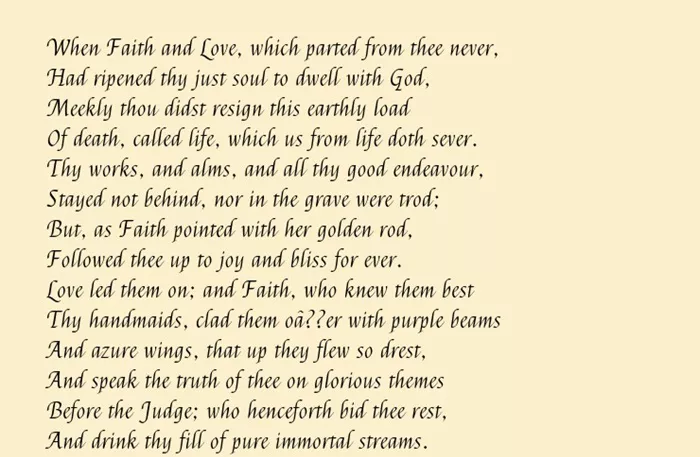Welcome to Poem of the Day – On the Religious Memory of Mrs. Catherine Thomson, My Christian Friend, Deceased Dec. 16, 1646 by John Milton
John Milton’s poem, On the Religious Memory of Mrs. Catherine Thomson, My Christian Friend, Deceased Dec. 16, 1646, is a profound reflection on death, faith, and remembrance. It explores themes of Christian devotion, the sorrow of loss, and the hope of eternal life. The poem, written in memory of Milton’s friend Catherine Thomson, is rich in religious undertones and personal grief. In this article, we will break down and explain the key elements of this poem in simple terms, shedding light on its meaning and significance.
On the Religious Memory of Mrs. Catherine Thomson, My Christian Friend, Deceased Dec. 16, 1646 Poem
When Faith and Love, which parted from thee never,
Had ripened thy just soul to dwell with God,
Meekly thou didst resign this earthly load
Of death, called life, which us from life doth sever.
Thy works, and alms, and all thy good endeavour,
Stayed not behind, nor in the grave were trod;
But, as Faith pointed with her golden rod,
Followed thee up to joy and bliss for ever.
Love led them on; and Faith, who knew them best
Thy handmaids, clad them o’er with purple beams
And azure wings, that up they flew so drest,
And speak the truth of thee on glorious themes
Before the Judge; who henceforth bid thee rest,
And drink thy fill of pure immortal streams.
On the Religious Memory of Mrs. Catherine Thomson, My Christian Friend, Deceased Dec. 16, 1646 Explanation
Historical Context and Background
Milton, one of the greatest poets of the English Renaissance, wrote this elegy in honor of his friend Catherine Thomson, who passed away in 1646. The poem is a meditation on her life and the Christian values she held dear. During this time, England was undergoing significant religious and political changes, marked by the English Civil War. Milton himself was a staunch Puritan, and his work reflects a deep commitment to Christian beliefs.
Theme of Grief and Loss
The poem begins with Milton mourning the death of his dear friend. He expresses his sorrow through the language of grief, acknowledging the pain of losing someone close. The sadness is not just personal but deeply connected to the Christian faith. The sense of loss is magnified by the belief that Thomson was a virtuous Christian, and her death leaves a void in both the earthly and spiritual realms.
Milton’s grief is not just about the loss of a friend but about the loss of a soul that he believed was destined for eternal peace with God. In this way, the poem intertwines personal loss with spiritual meaning, elevating the mourning process into something universal.
Religious Reflections
One of the central themes of the poem is religious faith. Milton emphasizes Thomson’s devotion to God, and this serves as a source of comfort for both the poet and the reader. Even in death, Thomson’s memory is preserved in the Christian faith she upheld during her life. The poem suggests that death is not an end but a transition into eternal life. Milton draws on Christian teachings to express the belief that Thomson’s soul is now in the hands of God, where it will find peace and eternal rest.
Through his reflection on Thomson’s life, Milton also invites readers to consider their own spiritual paths. The poem serves as a reminder of the importance of living a life of faith, devotion, and good deeds.
The Role of Memory and Legacy
Another important element of the poem is the idea of memory and legacy. Milton reflects on how the memory of his friend will live on, not just in his own heart but in the hearts of others who knew her. By writing this elegy, Milton ensures that her memory will be passed down through the generations. Her life, characterized by Christian virtues, serves as an example for others to follow.
This focus on legacy is particularly significant for Milton, who believed that one’s actions on earth should serve a greater, divine purpose. In remembering Thomson, Milton elevates her life to the level of sacredness, suggesting that the memory of virtuous individuals can transcend time and remain part of the spiritual consciousness.
Poetic Structure and Language
Milton’s use of language in this poem is both solemn and reverent. He employs a formal tone, appropriate for a piece written in memory of a friend. The poem is written in a style typical of elegies, with an elevated and dignified language that reflects the serious nature of the subject. Milton uses vivid imagery to describe both the grief he feels and the hope he has for Thomson’s soul.
The poem also demonstrates Milton’s skill in using meter and rhyme to convey his emotions. The rhythmic structure of the poem mirrors the steadiness and unchanging nature of faith, reinforcing the Christian message that death is but a part of a greater divine plan.
Conclusion
In On the Religious Memory of Mrs. Catherine Thomson, John Milton skillfully combines personal grief with religious reflection. Through his eloquent verse, he explores themes of death, faith, and remembrance, all framed within a Christian worldview. The poem serves as both a tribute to a beloved friend and a meditation on the eternal life that Christians believe awaits the faithful. Milton’s language, tone, and structure all work together to convey a message of hope and spiritual continuity, making this poem a powerful piece of both personal and religious significance.

